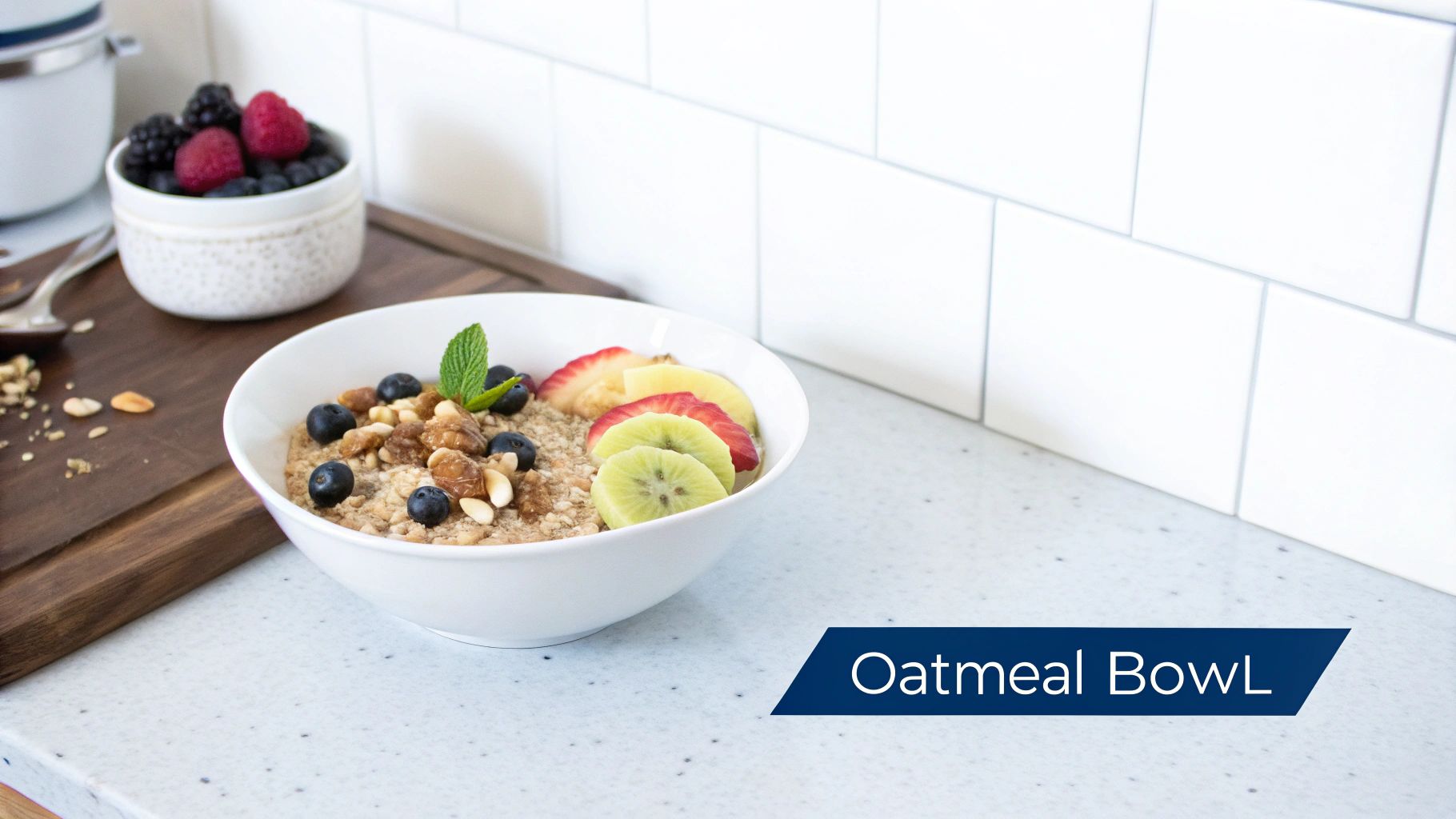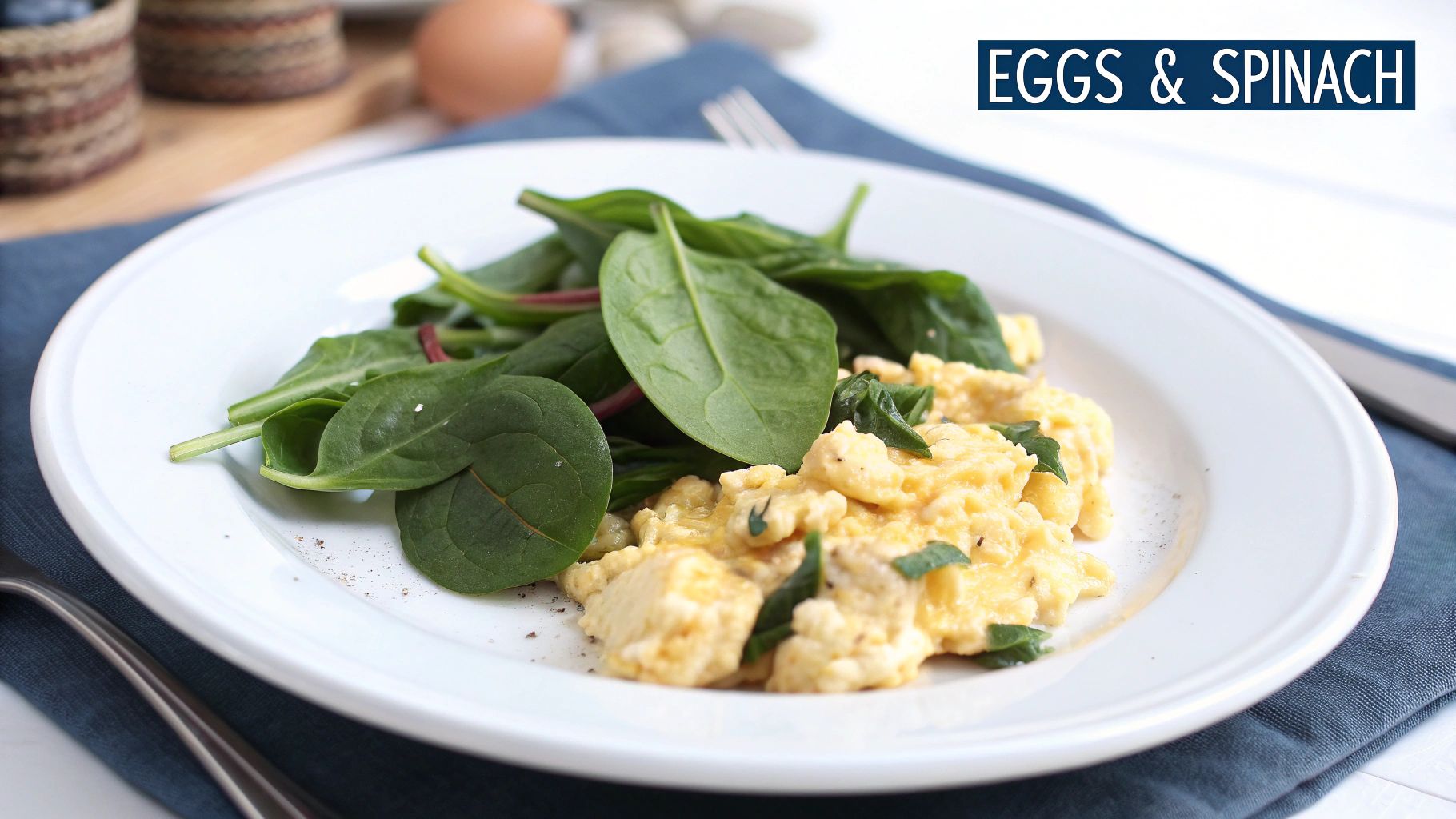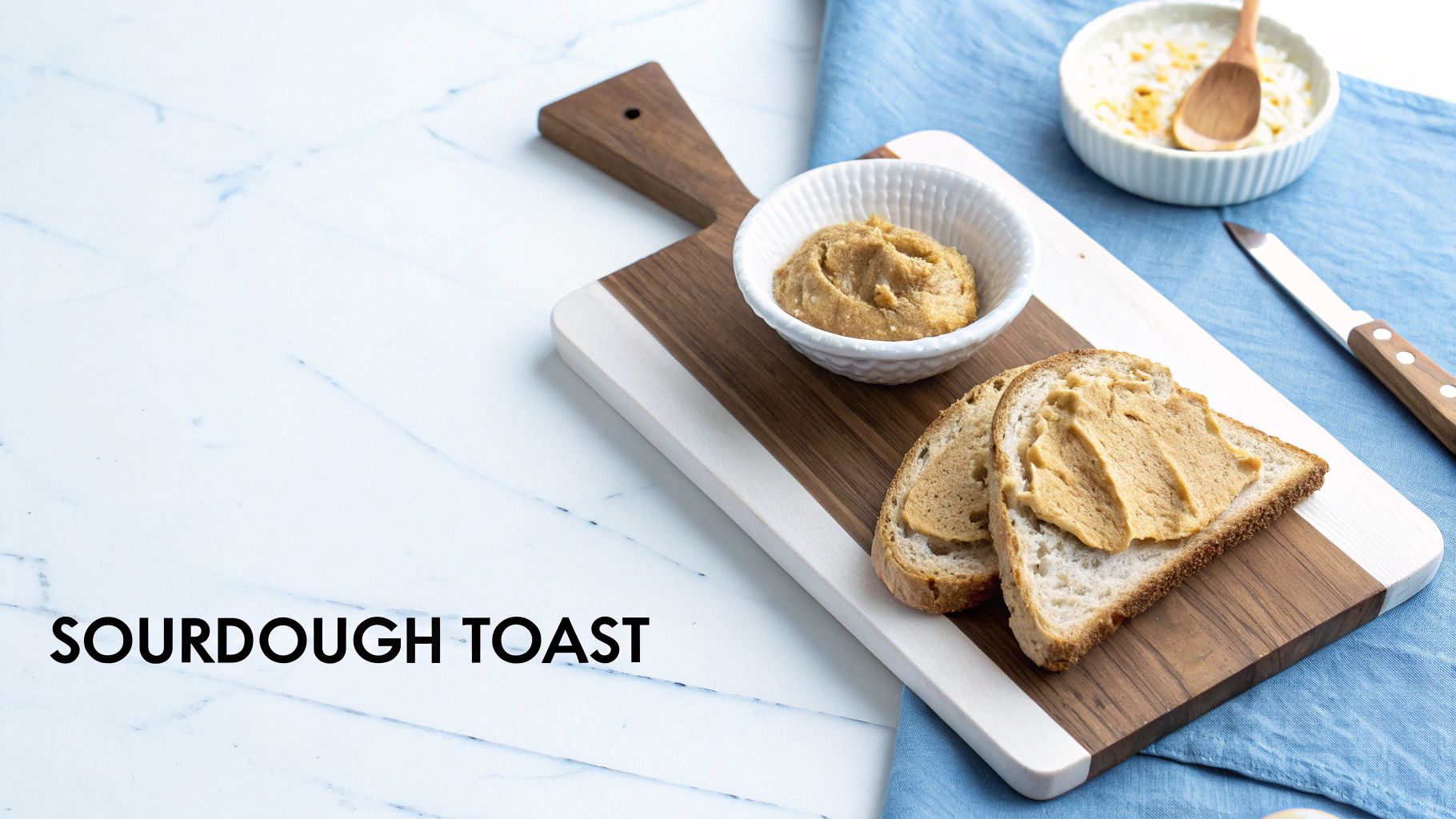Starting your day with a calm, happy gut is a game-changer when you live with Irritable Bowel Syndrome (IBS). The wrong breakfast can trigger a day of discomfort, bloating, and unpredictable symptoms. The right one, however, sets the stage for sustained energy, digestive peace, and feeling in control. This guide moves beyond generic advice to provide a curated list of genuinely gut-friendly breakfast for IBS options. We will explore specific, low-FODMAP-friendly recipes, explain the science behind why they work, and offer practical tips for preparation.
More importantly, we will delve into a powerful, often-overlooked ingredient for enhancing your morning meal: hemp protein. Discover how adding a clean, digestible protein can elevate these breakfasts from simply ‘safe’ to actively ‘supportive’ of your digestive health goals.
You will learn how to build satisfying meals that won't disrupt your system, including:
- Low FODMAP Oatmeal Bowl
- Banana Rice Porridge
- Scrambled Eggs with Spinach
- Quinoa Breakfast Bowl
- Lactose-Free Greek Yogurt Parfait
- Sourdough Toast with Peanut Butter
This article provides the actionable strategies you need to reclaim your mornings and manage your IBS effectively, one delicious breakfast at a time.
1. Low FODMAP Oatmeal Bowl
Oatmeal is a classic breakfast staple, but for individuals with Irritable Bowel Syndrome (IBS), it requires a thoughtful approach. A Low FODMAP Oatmeal Bowl is specifically designed to provide a comforting, fiber-rich start to your day without triggering common IBS symptoms like bloating, gas, and abdominal pain. This method centers on the Low FODMAP diet, a scientifically-backed eating plan developed by Monash University researchers that limits certain short-chain carbohydrates known to ferment in the gut.

The key to a successful IBS-friendly oatmeal is managing portion sizes and selecting the right ingredients. By using certified gluten-free rolled or quick oats and pairing them with gut-friendly toppings, you can create a delicious and safe breakfast for IBS.
How to Build Your Bowl
Creating a safe and satisfying oatmeal bowl is all about the details. Start with a foundation of oats and then carefully layer on flavors and textures from approved sources.
- Warm Oatmeal: Combine 1/2 cup of rolled oats with 1 cup of water or lactose-free milk. Top with a handful of blueberries (up to 40g is a green-light serving), a tablespoon of chopped pecans, and a sprinkle of cinnamon.
- Overnight Oats: In a jar, mix 1/2 cup of quick oats with 1/2 cup of unsweetened almond milk and 1 tablespoon of chia seeds. Stir in 5 sliced strawberries and let it sit overnight. In the morning, top with a spoonful of peanut butter.
Actionable Tips for Success
To ensure your oatmeal breakfast remains symptom-free, follow these expert-backed tips. These strategies, often highlighted by FODMAP dietitians like Kate Scarlata, can make all the difference.
Key Insight: The Monash University FODMAP Diet app is an invaluable tool for this process. It provides up-to-date information on safe portion sizes for hundreds of foods, taking the guesswork out of your meal prep.
- Start Small: Begin with a 1/2 cup (uncooked) portion of rolled or quick oats. Steel-cut oats can be higher in fructans, so test your tolerance with a smaller 1/4 cup serving first.
- Verify Toppings: Always check your fruits, nuts, and sweeteners. Safe choices often include strawberries, blueberries, kiwi, walnuts, pecans, and pure maple syrup in appropriate serving sizes.
- Go Gluten-Free: If you have celiac disease or a non-celiac gluten sensitivity, choose oats that are certified gluten-free to avoid cross-contamination.
- Prepare in Advance: Overnight oats are a fantastic option for busy mornings. Preparing them the night before ensures you have a ready-to-go, gut-friendly meal.
By carefully selecting your ingredients and minding portion sizes, an oatmeal bowl can be transformed from a potential trigger into a reliable and nourishing breakfast. For more ideas on managing digestive health with your diet, you can find a wealth of information in these delicious low FODMAP recipes for gut relief.
2. Banana Rice Porridge
When your digestive system is feeling particularly sensitive or you're experiencing an IBS flare-up, a gentle and easily digestible breakfast is crucial. Banana Rice Porridge is an excellent choice, drawing on the principles of the BRAT diet (Bananas, Rice, Applesauce, Toast), which is traditionally recommended by gastroenterologists for calming digestive distress. This simple, warm porridge uses white rice and ripe banana, two low-FODMAP and low-fiber ingredients that are soothing to the gut.

The combination of easily broken-down carbohydrates from the rice and the natural sweetness and gentle nature of a ripe banana makes this a comforting and safe breakfast for IBS. It provides energy without overburdening your system, making it an ideal meal to help you recover and reset.
How to Build Your Bowl
Creating this soothing porridge is simple and can be adapted to your preference. The goal is a creamy, gentle consistency that is easy on the stomach.
- Classic Porridge: Gently simmer 1/2 cup of white rice with 2 cups of water or a lactose-free milk alternative until the rice is very soft and the liquid has been absorbed into a creamy consistency. Stir in one mashed ripe banana and a drizzle of pure maple syrup.
- Coconut Banana Porridge: For a richer flavor, cook the rice in a mix of coconut milk and water. Top the finished porridge with sliced ripe banana and a sprinkle of cinnamon.
- Quick Leftover Rice Porridge: Transform leftover cooked white rice into a fast breakfast. Simply add the pre-cooked rice to a pot with enough lactose-free milk to cover, warm it through until creamy, and mash in a ripe banana.
Actionable Tips for Success
To ensure your rice porridge is as gut-friendly as possible, pay attention to these simple preparation details. These tips are based on traditional practices and dietitian recommendations for digestive health.
Key Insight: The ripeness of the banana is important. A ripe banana (yellow with some brown spots) is lower in FODMAPs and contains sugars that are easier to digest than those in an unripe, green banana.
- Use White Rice: Stick to white rice varieties like jasmine or basmati. Brown rice is higher in fiber and can be more difficult to digest during a flare-up.
- Overcook the Rice: The key to a creamy, digestible porridge is to cook the rice longer than you normally would. This helps break down the starches, making it gentler on your system. Aim for a 1:4 ratio of rice to liquid.
- Prep Ahead: Cook a larger batch of white rice for dinner and set some aside. This will drastically cut down on your breakfast preparation time the next morning.
- Control Sweeteners: While a ripe banana adds natural sweetness, if you add more, stick to low-FODMAP options like pure maple syrup in small quantities.
By using simple, well-cooked ingredients, Banana Rice Porridge can become a reliable and calming breakfast in your toolkit. To better understand how this fits into a larger strategy for managing symptoms, explore a comprehensive overview of the IBS diet plan your path to digestive freedom.
3. Scrambled Eggs with Spinach
Scrambled eggs offer a high-protein, easily digestible foundation for a satisfying breakfast, and pairing them with spinach adds valuable nutrients without common IBS triggers. This simple combination is naturally low in FODMAPs, providing a gentle yet energizing start to the day. For those managing IBS, a meal like this avoids the high-fiber, high-FODMAP ingredients often found in conventional breakfast dishes.

The beauty of this meal lies in its simplicity and adaptability. Eggs are a complete protein source, which can promote satiety and stable energy levels, while spinach is a well-tolerated green that wilts easily into the eggs. This makes it an ideal breakfast for IBS as it delivers sustenance without causing digestive distress.
How to Build Your Plate
Creating a gut-friendly scramble is about gentle cooking and mindful additions. Focus on fresh ingredients and low-heat methods to maximize flavor and digestibility.
- Classic Scramble: Whisk two eggs with a splash of lactose-free milk or water. Cook over low heat, and just before they are set, fold in a large handful of fresh baby spinach and a tablespoon of chopped fresh chives. Season with salt and pepper.
- Herb-Infused Eggs: Sauté 1 cup of spinach in a teaspoon of garlic-infused oil until just wilted, then set aside. Scramble two eggs with fresh dill and parsley, and serve alongside the sautéed spinach.
- Cheesy Spinach Scramble: Gently scramble two eggs. When they are nearly cooked, stir in a handful of spinach and 1/4 cup of grated hard cheese like cheddar or a lactose-free variety until the spinach has wilted and the cheese is melted.
Actionable Tips for Success
To ensure your egg breakfast supports your digestive health, consider these tips from experts in the field, including dietitians like Rachel Pauls who specialize in IBS management.
Key Insight: Avoid high-FODMAP alliums like garlic and onion powder. Instead, use garlic-infused oil to get the flavor without the fructans, or opt for the green tops of scallions or fresh chives.
- Low and Slow Cooking: Cook your eggs over low heat. High heat can make the protein tough and harder to digest for some individuals. A gentle scramble results in a softer, creamier texture.
- Add Spinach Late: Fold in the spinach leaves at the very end of the cooking process. You only need to cook them until they are just wilted to retain nutrients and prevent a watery texture.
- Use Fresh Herbs: Fresh herbs like chives, parsley, or dill add immense flavor without any FODMAPs. They are a much safer choice than many dried spice blends, which can contain hidden irritants.
- Watch Your Fats: Be mindful of the amount and type of fat used. A small amount of butter or a safe cooking oil, like garlic-infused olive oil, is typically well-tolerated.
- Test Individual Tolerance: While eggs and spinach are generally safe, always start with a small portion to see how your body responds before making it a regular meal.
4. Quinoa Breakfast Bowl
While often considered a savory lunch or dinner ingredient, quinoa makes a fantastic, nutrient-dense base for a breakfast bowl. A Quinoa Breakfast Bowl is a high-protein, naturally gluten-free option that can provide sustained energy without irritating the gut. Praised by ancient civilizations and modern superfood advocates alike, quinoa is a complete protein, meaning it contains all nine essential amino acids, making it an excellent choice for a powerful and satisfying breakfast for IBS.

The versatility of quinoa allows it to be served warm like porridge or cold as a breakfast salad. Its gentle fiber content is generally well-tolerated by individuals with IBS, especially when prepared correctly and paired with other low FODMAP ingredients. This makes it a reliable alternative to traditional breakfast grains that may cause digestive distress.
How to Build Your Bowl
Creating your quinoa breakfast bowl is simple and allows for great creativity with safe, gut-friendly ingredients. Start with cooked quinoa and add your favorite low FODMAP toppings for flavor, texture, and added nutrients.
- Warm Quinoa Porridge: Cook 1/2 cup of rinsed quinoa with 1 cup of coconut milk until tender and creamy. Stir in a teaspoon of maple syrup and top with a handful of blueberries and a tablespoon of toasted pumpkin seeds.
- Cold Quinoa Salad: Toss 1 cup of chilled, cooked quinoa with 1/4 cup of sliced strawberries, a few orange segments, and a tablespoon of chopped almonds. Drizzle with a small amount of maple syrup for sweetness.
Actionable Tips for Success
To get the most out of your quinoa breakfast and keep it symptom-free, follow these practical tips. These strategies, often recommended by gluten-free diet specialists, ensure digestibility and enhance flavor.
Key Insight: The natural coating on quinoa, called saponin, can have a bitter taste and may cause mild digestive irritation for some. Rinsing quinoa thoroughly under cold running water before cooking removes this coating, making it more palatable and easier to digest.
- Rinse Thoroughly: Always rinse your quinoa in a fine-mesh sieve for at least 30-60 seconds before cooking to wash away the natural saponins.
- Portion Control: A safe serving size for cooked quinoa on the low FODMAP diet is 1 cup. Start with this amount and adjust based on your personal tolerance.
- Boost Flavor: For a nuttier, richer flavor, toast the dry, rinsed quinoa in a pan for a few minutes before adding your cooking liquid.
- Batch Prep for Mornings: Cook a large batch of quinoa at the start of the week and store it in the refrigerator. This makes assembling your breakfast bowl quick and effortless on busy mornings.
5. Lactose-Free Greek Yogurt Parfait
Yogurt is celebrated for its probiotic content, but its lactose can be a major trigger for those with Irritable Bowel Syndrome (IBS). A Lactose-Free Greek Yogurt Parfait offers a perfect solution, delivering a protein-packed, creamy, and satisfying breakfast without the digestive distress. This approach allows you to enjoy the gut-health benefits of live active cultures while carefully managing your intake of FODMAPs.
This layered breakfast is more than just a visually appealing meal; it's a strategic way to combine protein, probiotics, and low-FODMAP fiber. By choosing a lactose-free Greek yogurt as your base and layering it with safe fruits and nuts, you can create a delicious and well-tolerated breakfast for IBS that supports both your energy levels and your digestive peace.
How to Build Your Parfait
Assembling a gut-friendly parfait is a simple process of layering safe ingredients. The key is to start with a proven base and add toppings that align with low-FODMAP guidelines.
- Classic Berry Parfait: In a glass, layer 1 cup of plain, lactose-free Greek yogurt with a handful of blueberries (up to 40g) and a tablespoon of crushed walnuts. Repeat the layers and serve immediately.
- Strawberry Chia Parfait: Start with a layer of lactose-free strawberry-flavored yogurt (check for no high-FODMAP sweeteners). Top with sliced strawberries (up to 65g) and a sprinkle of chia seeds.
- Tropical Coconut Parfait: Use a lactose-free coconut yogurt as your base. Add a small, safe portion of pineapple (up to 140g) and a sprinkle of toasted coconut flakes for a tropical twist.
Actionable Tips for Success
To ensure your parfait is a safe and enjoyable experience, pay close attention to ingredient labels and portion sizes. These tips, often recommended by dietitians specializing in digestive health, will help you avoid common pitfalls.
Key Insight: Many individuals with IBS can tolerate the small amounts of lactose in traditional Greek yogurt because the straining process and live cultures help break it down. However, choosing a certified lactose-free version removes all guesswork and provides an extra layer of security.
- Read the Label: Opt for plain lactose-free yogurt to avoid hidden high-FODMAP ingredients like inulin (chicory root), high fructose corn syrup, or fruit juice concentrates.
- Prep for the Week: Assemble several parfaits in mason jars for a quick grab-and-go breakfast. Keep crunchy toppings like nuts or granola separate and add them just before eating to maintain texture.
- Boost with Protein: If you need an extra protein boost to stay full longer, consider mixing in a scoop of a gut-friendly protein powder. You can explore a variety of choices in this guide to the best protein powder for IBS in 2025.
- Mind Your Fruits: Stick to low-FODMAP fruits in their designated safe-serve sizes. Strawberries, blueberries, raspberries, kiwi, and oranges are excellent choices.
6. Sourdough Toast with Peanut Butter
For many with IBS, bread is often a source of discomfort, but traditional sourdough offers a delicious exception. Sourdough Toast with Peanut Butter is a simple yet effective breakfast that leverages the ancient art of fermentation to make wheat more digestible. The slow fermentation process used to make authentic sourdough breaks down fructans, a type of FODMAP that can trigger symptoms in sensitive individuals.
Pairing this gut-friendly bread with natural peanut butter adds a satisfying dose of protein and healthy fats, creating a balanced and energizing meal. This combination provides sustained energy without the common pitfalls of highly processed breads, making it an excellent breakfast for IBS management.
How to Build Your Toast
A great sourdough toast starts with quality ingredients. Choose your bread and toppings carefully to ensure a symptom-free experience.
- Classic & Simple: Take two slices of true sourdough toast and spread each with one tablespoon of natural peanut butter.
- Sweet & Savory: Top your sourdough toast with peanut butter and add thin slices of banana (up to one-third of a medium banana is a safe portion).
- Warm & Spiced: Create an open-faced sourdough toast with peanut butter and finish with a light sprinkle of cinnamon for added flavor and warmth.
Actionable Tips for Success
To get the most out of this breakfast option, paying attention to the details is crucial. These tips, often emphasized by artisan bread experts like Peter Reinhart and gut-health dietitians, will help you enjoy bread again.
Key Insight: The "sourdough" label can be misleading. Many commercial brands add yeast for a quick rise and sour flavoring, which does not reduce the FODMAP content. Look for bread made with only flour, water, salt, and a starter.
- Seek Traditional Fermentation: Choose sourdough bread that has undergone a long fermentation process (at least 24 hours). This is key to breaking down the fructans. Check bakery labels or ask your local baker about their process.
- Choose Natural Peanut Butter: Opt for peanut butter containing only peanuts and salt. Avoid brands with added sugars, hydrogenated oils, or high-fructose corn syrup, which can be gut irritants.
- Mind Your Portions: Stick to a serving of one to two slices of sourdough toast. While lower in FODMAPs, large quantities can still cause issues for some.
- Toast for Digestion: Lightly toasting the bread can help break down carbohydrates further, potentially making it even easier to digest.
- Consider Alternatives: If peanuts are a trigger for you, almond butter is a great low-FODMAP alternative. A serving of one tablespoon is generally well-tolerated.
Breakfast Options for IBS: Key Features Comparison
| Breakfast Item | 🔄 Implementation Complexity | 🛠️ Resource Requirements | 📊 Expected Outcomes | 💡 Ideal Use Cases | ⭐ Key Advantages |
|---|---|---|---|---|---|
| Low FODMAP Oatmeal Bowl | Moderate (portion control needed) | Quick oats, low FODMAP fruits, nuts | Aids digestion, sustained energy | IBS management with fiber focus | Scientifically backed, customizable |
| Banana Rice Porridge | Low (simple cooking) | White rice, ripe bananas | Gentle digestion, quick energy | IBS flare-ups, gentle carb source | Extremely gentle, inexpensive |
| Scrambled Eggs with Spinach | Low (quick cooking) | Eggs, fresh spinach, herbs | High protein, nutrient-rich | Protein boost, low FODMAP meals | High protein, quick and versatile |
| Quinoa Breakfast Bowl | Moderate to High (prep time) | Quinoa, low FODMAP fruits, nuts | Complete protein, sustained energy | Gluten-free, nutrient-dense breakfasts | Complete protein, high fiber |
| Lactose-Free Greek Yogurt Parfait | Moderate (layering prep) | Lactose-free Greek yogurt, fruits | Protein, probiotics for gut health | IBS with dairy sensitivity, probiotic support | High protein & probiotics, visually appealing |
| Sourdough Toast with Peanut Butter | Low (basic prep) | Traditional sourdough bread, peanut butter | Digestible carbs, balanced macros | IBS-friendly wheat alternative | Fermented bread for digestibility, quick |
Your Action Plan for a Better Breakfast Experience
Navigating the world of breakfast with IBS can feel like a daunting task, but as we've explored, you have a wealth of delicious and gentle options at your fingertips. Moving beyond the anxiety of potential triggers requires a proactive and personalized approach. The journey to a calmer gut begins with small, consistent steps, transforming your morning meal from a source of stress into a powerful tool for well-being.
The core takeaway from our exploration of recipes like Low FODMAP Oatmeal, Quinoa Breakfast Bowls, and Scrambled Eggs with Spinach is that a satisfying breakfast for IBS is built on a foundation of safe, whole-food ingredients. It’s not about restriction; it’s about strategic substitution and mindful preparation. The goal is to build your own unique rotation of go-to meals that you know you can rely on, day in and day out.
From Knowledge to Action: Your Next Steps
The true power lies not just in knowing these recipes but in implementing them methodically. Here is a clear, actionable plan to get started:
- Select and Test: Choose just one recipe from this list that genuinely appeals to you. Commit to trying it for three consecutive days, paying close attention to your body's response.
- Keep a Simple Journal: You don't need a complex system. A simple note on your phone will do. Record the meal you ate and a brief note on how you felt 1-2 hours later. This practice is invaluable for identifying your personal trigger foods and safe foods.
- Master One, Then Add Another: Once you've confirmed a recipe works well for you, add it to your "safe list." Then, move on to the next recipe and repeat the process. Over a few weeks, you will have built a reliable menu of 2-3 breakfast options, eliminating morning guesswork.
Key Insight: Consistency is more important than variety in the beginning. The objective is to establish a baseline of what makes your gut happy before reintroducing more complex ingredients.
The Bigger Picture: Long-Term Digestive Wellness
Mastering your breakfast is a crucial first step toward managing your IBS symptoms effectively. A well-chosen morning meal sets the tone for your entire day, stabilizing your blood sugar, providing sustained energy, and preventing the digestive distress that can derail your productivity and mood.
By focusing on low FODMAP principles, prioritizing easily digestible proteins, and being mindful of portion sizes, you are actively taking control of your health. This empowerment extends far beyond the breakfast table. It builds confidence in your food choices and provides a framework for approaching other meals, helping you navigate lunches, dinners, and social situations with greater ease. Ultimately, finding the right breakfast for IBS is a foundational habit that supports a more predictable, comfortable, and energetic life.
Ready to enhance your gut-friendly breakfasts with a clean, powerful protein boost? Try adding a scoop of Cantein to your oatmeal, porridge, or smoothies. Formulated with just one ingredient, our hemp protein is free from the common gut irritants found in other supplements, making it the perfect choice for your sensitive digestive system. Explore Cantein today and give your mornings the support they deserve.

